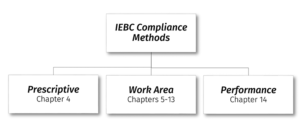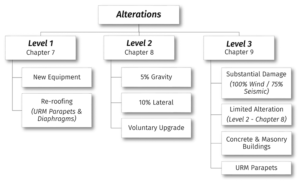Throughout the United States, many jurisdictions are now adopting the 2015 International Codes. Perhaps the greatest impact to structural engineers is the fact that Chapter 34 of the 2015 International Building Code (IBC) has been removed. This chapter provided minimum design requirements for existing buildings. When a mandatory trigger, such as a change in occupancy, requires a seismic evaluation of an existing structure, the design professional now has the option of either showing compliance with the IBC as if it were new construction or conforming to the provisions of the International Existing Building Code (IEBC). How familiar are you with the IEBC?
IEBC Background
The IEBC was first introduced in 2003 after an exhaustive effort that began in 2000. The original intent was to create a comprehensive set of regulations for existing buildings based on the requirements previously included in the codes developed by BOCA, ICBO, and SBCCI. The purpose of the IEBC is to encourage the use and reuse of existing buildings while also maintaining minimum life safety requirements.
While the IEBC was first introduced in 2003, it has taken quite some time for it to be accepted and actually adopted for use throughout the United States. Several associations were not happy with portions of the initial code requirements and, as a result, quite a few changes have been made since its introduction. The International Code Council’s website currently shows that more than half of States throughout the U.S. have currently adopted the IEBC either statewide or approved it for local adoption. Because Chapter 34 of the IBC has now been removed, even more states and local jurisdictions will be turning to the IEBC.
The initial thought might be, “Just what we need, another code!” While it may require designers to learn something new, it also provides much more flexibility for the reuse of existing buildings. Section 101 of the IBC now lists the IEBC as a companion code similar to the mechanical, plumbing, fire, and energy codes. Like it or not, the IEBC appears to be here to stay.
Compliance Methods
The beauty of the IEBC is that it allows the owner and design professional to select one of several paths for code compliance. As shown in Figure 1, there are three compliance options: (1) Prescriptive, (2) Work Area, and (3) Performance. It is important to know that mixing-and-matching is not allowed and once a compliance path has been chosen all members of the design team must follow that same path. If the architect desires to follow the performance method, then all members of the design team will also need to comply with the performance method requirements.
General Requirements
Chapters 1 through 3 of the IEBC cover general provisions that are applicable to all three compliance methods. As with all of the International Codes, Chapter 1 covers scope and administrative provisions while Chapter 2 provides definitions of key terms used throughout the code. It is very important that both the design professional and local authorities having jurisdiction (AHJ) have an understanding of Chapter 3. The following are some key items defined in Chapter 3:
- Seismic Forces Levels: Throughout the code, specific triggers will require a seismic evaluation of the entire structure or of an individual component. Each time a trigger is specified, it will state whether the evaluation needs to meet the full IBC code-level or the “reduced” code-level seismic forces. Section 301.1.4.2 of the IEBC clarifies that the “reduced” code-level forces are equivalent to evaluations (1) considering 75% of the IBC prescribed forces, (2) using Appendix A of the IEBC, or (3) complying with Table 301.1.4.2 of the IEBC when using ASCE 41.
- Performance Objectives: Structural engineers must be intimately familiar with Tables 301.1.4.1 and 301.1.4.2 of the IEBC prior to commencing a seismic evaluation of an existing structure. These tables clarify the minimum performance levels expected for existing buildings based upon risk category. Many structural engineers have been accustomed to evaluating existing buildings to meet the Basic Safety Objective (BSO) described in ASCE 41 but, per the IEBC, that would not be adequate for a Risk Category III or IV structure.
- New and Replacement Materials: All new construction and new materials used as part of the work must comply with the requirements of the current IBC unless specifically noted otherwise in the IEBC.
In addition, there are two other key items to be aware of regardless of which compliance method is chosen. First, all new structural elements and their connections are to comply with the requirements of the IBC. Second, if the existing structure is located within a flood hazard area and the repairs, alterations or additions performed constitute a “substantial improvement,” the entire structure will be required to comply with Section 1612 of the IBC or Section R322 of the International Residential Code.
Prescriptive Method
The prescriptive method is essentially a duplicate of the provisions previously provided under Chapter 34 of the IBC. Structural triggers are specified for additions, alterations, repairs, change of occupancy, historic buildings, and moved structures. The prescriptive method will not be discussed in detail in this article due to its previous incorporation in the IBC.
Work Area Method
The work area method is the most flexible of the three compliance options and comprises Chapters 6 through 13 of the IEBC. It provides many benefits to building owners and design professionals, building on the premise that specific code provisions are only triggered if the scale and level of work warrant.
Repairs
When it comes to repairs, the key term to consider is Substantial Structural Damage. When the required repairs are less than substantial, as defined by Chapter 2 of the IEBC, the building can be repaired to its pre-damaged state. Those repairs that are considered substantial require an evaluation using the full IBC wind loads and “reduced” seismic.
Alterations
The work area method actually divides alterations into three separate categories, Level 1 through Level 3 (Figure 2). Level 1 alterations are considered very minor, such as the addition of new mechanical equipment or re-roofing. Re-roofing can also trigger the requirement to brace unreinforced masonry parapets in Seismic Design Categories D-F or to upgrade diaphragm connections in high wind regions.
Level 2 is a “catch-all” for alteration work that does not fall into the Level 1 or Level 3 categories. Most alteration projects will likely fall under this category. Level 2 is very similar to the requirements provided in the prescriptive method and is based on the 5% gravity and 10% lateral rules. That is, if existing gravity members have been decreased in capacity by more than 5%, or more than 5% additional load has been placed on them due to the alteration, those members must be analyzed to show compliance with the current IBC requirements. Similar to the gravity requirements, if lateral load carrying members have been decreased in capacity by more than 10%, or more than 10% additional loads will be applied to them, an analysis must be completed.
The difference between lateral and gravity members is that the 10% rule now triggers an analysis of the entire structure while the 5% gravity rule only requires an analysis of that one member. A key benefit to analyzing alterations using the work area method rather than the prescriptive or performance methods is that the evaluation can be performed using the “reduced” seismic forces.
Level 2 alterations also include voluntary seismic upgrades. Voluntary upgrades simply require an engineering analysis showing that the building will be no less compliant and that new components comply with the current IBC provisions.
Level 3 alterations only apply to projects considered as Substantial Structural Alterations. These are defined as projects that will undergo alterations within a 5-year period of time that affect more than 30% of the total floor and roof areas. When this occurs, the IEBC requires an analysis of the lateral systems for the full IBC wind loads and “reduced” seismic forces. Additional provisions are also required for ensuring that a proper roof-to-wall attachment is provided for existing masonry and concrete buildings, and for the bracing of unreinforced masonry parapets.
Additions
The requirements for additions are very similar to Level 2 alterations. Both the 5% gravity and the 10% lateral rules still apply, but the major difference is that if the 10% lateral trigger has been met, the evaluation provided must consider the full IBC wind and full seismic forces. The provisions for alterations allow the use of “reduced” seismic forces in the evaluation.
Change of Use
Similar to past IBC requirements, buildings undergoing a change of use are only required to provide a seismic evaluation if the new use causes the building to be assigned to a higher Risk Category per Table 1604.5 of the IBC. In addition, all gravity members should be checked to ensure that they can support higher live loads, if applicable, per Table 1607.1 of the IBC.
Historic Buildings
For buildings located in Seismic Design Categories D-F, a structural evaluation must be provided describing the strengths and weaknesses of the vertical and horizontal elements of the lateral force resisting system. All deficiencies should be noted in a report and discussed in a meeting with the owner and building official. While a complete seismic upgrade is not required, all dangerous conditions must be remedied.
Moved Buildings
Under Chapter 34 of the IBC, the evaluation for a moved structure was required to show that it met the requirements for a new building. Per the IEBC, this requirement is only triggered when the building is moved to a location such that the new snow, wind, and seismic loads trigger the 5% gravity or 10% lateral rules. In truth, the building would still need to be analyzed in order to properly design the foundation system and anchorage of the building to the foundation.
Performance Method
The performance method is likely the least understood and the least used. It provides the building owner and design team with a method to score the existing fire and life-safety conditions of a building. If the score is below the minimum accepted level, the building owner and the building official should determine what improvements need to be made to raise the score to an acceptable level. While fire and life-safety items receive a score, a detailed structural analysis must also be provided considering the full IBC wind and seismic loads. The structural analysis report listing any noncompliant items must be presented to the building official along with documentation for updating any noncompliant items.
Conclusion
As Chapter 34 of the IBC has been removed, design professionals will have an increased need to learn and rely upon the provisions included in the IEBC. The purpose of the IEBC is to encourage the use and re-use of existing buildings while requiring reasonable upgrades and improvements. It offers several paths for compliance which provide flexibility to both building owners and to design professionals. In many cases, buildings may only need to meet the “reduced” seismic requirements whereas they previously were required to comply with the full seismic loads under the IBC. In addition, the IEBC allows the building official to use discretion in determining what minimum code requirements need to be met and to ensure that all dangerous conditions are alleviated. The building officials will likely rely upon the recommendations of the structural engineer when making such a determination. All design professionals should take some time to become familiar with the IEBC provisions, as they will likely be referring to it often in the future.▪


